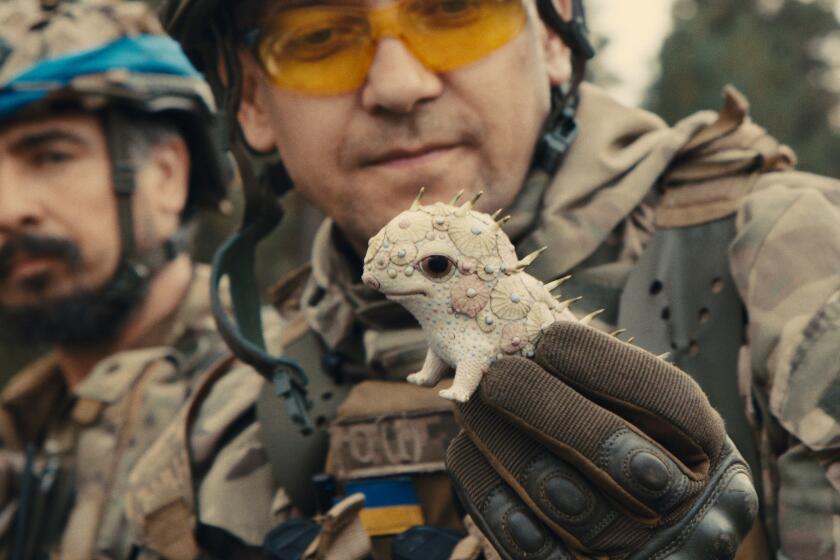Review: A pulsating documentary takes up ‘The Fight Against Native American Mascoting’

- Share via
Striving for meaningful visibility is hard enough for the marginalized Indigenous peoples of America without them having to also fight its spurious, racist flip side: the harmful stereotype industry of sports mascoting that keeps Native Americans in an Other-ized loop as a culturally disrespected and perpetually demeaned underclass.
The movement to get sports leagues, intransigent owners, and rabid fans to grasp the offensiveness in Native-themed team names, images and longstanding gestures — and harder yet, scrap them entirely — is the central subject of Ben West’s and Aviva Kempner’s pulsatingly argued, wide-ranging, and occasionally seething documentary “Imagining the Indian: The Fight Against Native American Mascoting.” Where movies and television have made the necessary changes onscreen (if not fully behind the camera), the sports world still clings to its affronts.
Over a hundred years of culturally ignominious representation in media, and the struggle to counter it, may be a lot to cram into one 90-minute movie full of interviews, informational perspective, and archival footage. But some films benefit from tying their persuasive abilities to sustained righteousness more than careful slickness, and this collaboration between Cheyenne filmmaker West and veteran documentarian Kempner (“The Life and Times of Hank Greenberg”) is one of them.
Viewers afterward will hopefully think twice before casually tossing around the slur representing Washington D.C.’s football team until just last year, a moniker directly tied to the history of violence perpetuated on Native Americans (and specifically the ghastly practice of proof for bounties). That the franchise is now the Washington Commanders may represent a massive, encouraging victory. But learning that over 2,000 high schools across the country still using Native-themed mascots — all those R-words, Indians, Chiefs and Braves — gives the viewer a sense of the deep entrenchment for this disgraceful slice of symbolized history, which has been shown in studies referenced in the documentary to directly impact the mental health of young Native peoples everywhere.
Besides, the appropriation is usually ahistorical in its cartoonishness, from the stadium-favorite “tomahawk chop” that never existed, to the insulting headdresses and facepaint, and the warrior imagery that keeps Indians stigmatized as violent people — mascots typically tied to animalistic tendencies, not dimensionalized humans. Conveniently ignored, of course, are who did all the brutal displacing in the first place. (Not that anyone these days would root for a team called the Fighting Colonists.)
It’s not always the cleanest approach for an advocacy doc to pack a running time with an abundance of talking heads, the testimony and context like a fast-moving river when sometimes you want to sit awhile with the totality of what you’re ingesting. But the Native and non-Native interviewees here — over 50 activists, historians, researchers, athletes, writers, and politicians — feel like a necessary strength-in-numbers corrective when battling a pervasively dehumanizing, monolithic depiction of a vast and varied people across all walks of life.
Though some aspects of the fight are dispiriting — there’s lots of footage of crassly stubborn sports fans — there are also advancements to treasure, like one non-Native teen turning her education into a successful campaign to change her school’s name. A lot of hope in the movie stems from the belief that successive generations will get louder and louder.
And in much the way the disability rights documentary “Crip Camp” introduced unaware viewers to the efforts of long-in-the-trenches advocates, “Imagining” shines a much-needed spotlight on the tireless, heroic work of a key figure: poet, Native American rights activist and 2014 Presidential Medal of Freedom recipient Suzan Shown Harjo, who’d led the charge against D.C.’s gridiron name for 50 years. “Imagining” belongs in the category of issue docs that suggest ready spinoffs, because if anyone deserves their own film, the eloquent, witty and tough-talking Harjo does. What she deserves even more than that, however, is what “Imagining the Indian” calls for: a social justice win on mascoting for America’s original home team.
'Imagining the Indian: The Fight Against Native American Mascoting'
Not rated
Running time: 1 hour, 35 minutes
Playing: Starts April 14, Laemmle Monica, Santa Monica
More to Read
Only good movies
Get the Indie Focus newsletter, Mark Olsen's weekly guide to the world of cinema.
You may occasionally receive promotional content from the Los Angeles Times.










